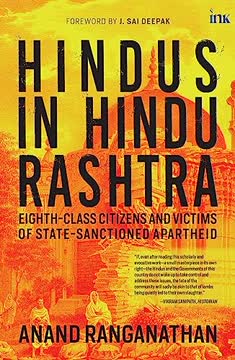Key Takeaways
1. Hindus face State-Sanctioned Apartheid in India.
Worse than appeasement of one community is apartheid against other communities.
Discrimination over Appeasement. The book argues that while minority appeasement exists, the active discrimination against Hindus is a more significant issue. This discrimination is embedded in the Constitution, policies, and legal framework, making Hindus feel like second-class citizens in their own country.
Examples of discrimination:
- State control of Hindu temples
- Injustice towards Kashmiri Hindus
- The Waqf Act
- The RTE Act
Political realities. The author points out that appeasement is often politically motivated to win elections, but the systemic discrimination against Hindus is a deeper, more harmful problem. This discrimination persists regardless of which political party is in power.
2. State Control of Hindu Temples is a Financial Scam.
State control of Hindu temples and their property is by far the largest, financially most damaging scam of independent India.
Loot and Pillaging. The state control of Hindu temples is portrayed as a massive financial scam, surpassing even the petroleum sector in terms of financial damage. The author argues that if religion should be kept out of the State, the State should be kept out of religion.
Examples of State Control:
- Governments of just 10 states control more than 110,000 Hindu temples.
- Tamil Nadu government alone controls 36,425 temples and 56 mutts.
- The communist State of Kerala has five Devaswom boards managing 3,058 temples.
Financial Impact. The loss to Hindu temples due to state control is estimated to be in the lacs of crores over decades. This loss prevents temples from funding ved pathshalas, schools, colleges, gaushalas, fellowships, scholarships, orphanages, and Hindu cultural and religious centers.
3. Kashmiri Hindus Suffer Unjustly in Their Own Land.
We live in a nation of broken mirrors, where you possess neither a shadow nor a reflection if you are a Kashmiri Hindu.
Ethnic Cleansing. The book highlights the injustice faced by Kashmiri Hindus, who were ethnically cleansed from their homeland. Despite the high tourist footfall in Kashmir, the government has failed to provide adequate housing and security for the original inhabitants.
Examples of Injustice:
- Only 17% of promised houses for Kashmiri Hindus have been completed in the last six years.
- Only 5,928 Kashmiri Hindus have been appointed through the Prime Minister’s Job Scheme.
- Kashmiri Hindus who want to flee because they fear for their lives, are being kept locked up.
The Kashmir Files. The film "The Kashmir Files" has tried to reset the Kashmiri Hindu narrative, but many prominent Kashmiri voices have called for a ban on the film. The author argues that there can be no reconciliation without remembrance.
4. The Waqf Act Enables Land Grabbing.
Waqf is the third-largest landowner in India.
Land Ownership. The Waqf is the third-largest landowner in India, with much of its landholding dating back to pre-independence times. The Waqf Act, 1995, gives the Waqf Board extensive powers to declare properties as Waqf land.
Examples of Waqf Properties:
- Seventy-seven percent of Delhi is on Waqf land, including the Delhi High Court.
- Central Vista, CGO Complex, and Jawaharlal Nehru Stadium are on Waqf land.
- The Waqf Board lays claim to 354,913 estates and 866,035 properties comprising 802,000 acres of Indian land.
Draconian Powers. The Waqf Act, 1995, bestows on the Waqf survey commissioner the authority and power like that of a civil court. It also gives the Waqf power to decide if your land is Waqf or not.
5. The RTE Act Discriminates Against Hindu Schools.
All religious schools are equal, but some are less equal than others.
Unequal Application. The Right to Education Act (RTE) selectively applies to non-minority schools, leading to discrimination against Hindu-run schools. The Act mandates that 25% of seats must be allotted to children from economically weaker sections (EWS), but this does not apply to minority schools.
Examples of Discrimination:
- Non-Minority schools cannot have a capitation fee or screen students they want admitted.
- The reimbursement of fee by the government is never timely, forcing the school to go under debt, even shut shop.
- You have to have a government-mandated selection procedure for teachers-one that includes a quota-driven recruitment.
School Closures. In 2017, the National Independent School Alliance (NISA) compiled a list of schools in 12 states that had been asked to shut down for non-compliance to the RTE’s draconian provisions. As many as 7,000 schools in Maharashtra had been told to shut down.
6. Laws Appease Non-Hindus and Target Hindus.
In Hinduism, religion is an offshoot of the way of life, while in Islam, way of life is an offshoot of religion.
Double Standards. The book argues that the State often applies different standards to Hindus and non-Hindus, reforming Hindu practices while avoiding similar reforms in other religions. This leads to a situation where laws appease non-Hindus and target Hindus.
Examples of Double Standards:
- Bigamy is banned under Indian law but permitted under Muslim Personal Law.
- The Prevention of Communal and Targeted Violence (Access to Justice and Reparations) Bill, 2011, was drafted to protect minorities but could have been used to discriminate against Hindus.
- Feminists outrage on Karvachauth but slither away under their favorite Parthasarathy rock when it comes to giving equal inheritance rights to Muslim women.
Ambedkar's Criticism. The author highlights Dr. Ambedkar’s criticism of the selective criticism of Hinduism, noting that Muslim society in India is afflicted by the same social evils as Hindu society.
7. The Judiciary Often Reforms Only Hinduism.
Notions of rationality cannot be invoked in matters of religion.
Selective Intervention. The judiciary is often seen as selectively intervening in Hindu religious practices while avoiding similar interventions in other religions. This is exemplified by the Sabarimala verdict, which went against the temple's centuries-old tradition.
Examples of Selective Intervention:
- The Tripura High Court banned animal sacrifice even though Hindus argued that this practice was a centuriesold tantric tradition.
- The judges of Himachal Pradesh High Court had similarly banned the 600-year-old tradition of animal sacrifice during Kullu Dussehra.
- The quasijudicial NGT ordered a ban on the tolling of bells and the chanting of shlokas by devotees at Amarnath.
Animal Sacrifice. The author questions why only the religious Hindu is prevented from conducting animal sacrifice, while the practice of halal is not similarly scrutinized.
8. India Celebrates Those Who Killed Hindus.
Our history has been written by those who hated Hindus, Hinduism and Hindustan.
Honoring Destroyers. The book criticizes the practice of honoring historical figures who killed and converted millions of Hindus. This includes naming cities and roads after these figures and venerating them in various ways.
Examples of Honored Destroyers:
- Bakhtiyar Khilji, who destroyed Nalanda University, has a railway station and a city named after him.
- Babur, who destroyed temples, has a road named after him in Central Delhi.
- St Francis Xavier, who led the Goa inquisition, is venerated by millions of Indians.
Tipu Sultan. The author highlights the case of Tipu Sultan, who destroyed temples and converted thousands, yet is often celebrated as a symbol of communal harmony.
9. The Places of Worship Act Perpetuates Injustice.
This law speaks to our history and to the future of the nation? No. This law airbrushes our history and destroys our future.
Maintaining Injustice. The Places of Worship Act, 1991, mandates maintaining all religious places as they were on 15 August 1947, effectively preventing the correction of historical injustices. The Supreme Court's ratification of this Act in 2019 is criticized.
Examples of Injustice:
- The historical injustice of Kashi or Mathura can now never be addressed unless the Parliament overrides this Act.
- The Nandi at the Gyanvapi Mosque has been waiting for 400 years for his lord to emerge.
- The Act prevents the reclamation of demolished places of worship and the correction of historical injustices.
Call for Abrogation. The author calls for the abrogation of the Places of Worship Act, arguing that it is a barbaric legislation that airbrushes history and destroys the future.
Last updated:
FAQ
What’s "Hindus in Hindu Rashtra" by Anand Ranganathan about?
- Central Thesis: The book argues that Hindus, despite being the majority in India, face state-sanctioned discrimination and are treated as "eighth-class citizens" in their own country.
- Eight Illustrations: Ranganathan identifies and analyzes eight key areas—legal, legislative, and societal—where Hindus are systematically disadvantaged.
- Focus on Policy and Law: The book critiques both historical and current governments, including the BJP, for perpetuating or failing to address this discrimination.
- Evidence-Based Approach: The author uses legal documents, historical references, and contemporary examples to substantiate his claims.
Why should I read "Hindus in Hindu Rashtra" by Anand Ranganathan?
- Unique Perspective: The book offers a contrarian view to the mainstream narrative that India is becoming a "Hindu Rashtra" hostile to minorities, arguing instead that Hindus are institutionally disadvantaged.
- Comprehensive Analysis: It provides detailed, referenced discussions on laws, policies, and court judgments affecting Hindus.
- Awareness and Advocacy: Readers interested in Indian politics, law, and society will gain insight into lesser-discussed aspects of secularism and minority rights.
- Call to Action: The book encourages Hindus and policymakers to recognize and address these systemic issues.
What are the key takeaways from "Hindus in Hindu Rashtra" by Anand Ranganathan?
- State Control of Temples: Hindu temples are uniquely subject to state control and financial exploitation, unlike places of worship of other religions.
- Legal and Constitutional Discrimination: Laws like the Waqf Act, RTE Act, and Places of Worship Act institutionalize discrimination against Hindus.
- Judicial and Legislative Bias: The judiciary and legislature often target Hindu practices for reform while avoiding similar scrutiny of other religions.
- Historical Narrative Manipulation: The book claims that Indian history education and public memory glorify invaders and downplay atrocities against Hindus.
How does Anand Ranganathan define "state-sanctioned apartheid" against Hindus in "Hindus in Hindu Rashtra"?
- Legal Discrimination: The author uses the term to describe laws and policies that explicitly or implicitly disadvantage Hindus, such as state control of temples and selective application of educational regulations.
- Political Tokenism: He argues that political parties, including those seen as pro-Hindu, offer only symbolic gestures without substantive policy change.
- Entrenched in Constitution: Ranganathan claims that this discrimination is embedded in constitutional amendments and legal frameworks.
- Societal Impact: The result is a Hindu majority that is fragmented, marginalized, and denied equal rights in key areas.
What are the eight main areas of discrimination against Hindus identified in "Hindus in Hindu Rashtra"?
- State Control of Hindu Temples: Government management and financial exploitation of Hindu religious institutions.
- Injustice towards Kashmiri Hindus: Lack of justice and rehabilitation for victims of the Kashmiri Hindu exodus and genocide.
- The Waqf Act, 1995: Special legal privileges and powers granted to Muslim religious endowments, often at the expense of Hindu property rights.
- The RTE Act: Selective application of the Right to Education Act, burdening Hindu-run schools while exempting minority institutions.
- Legislations Targeting Hindus: Laws and bills that reform or restrict Hindu practices but avoid similar reforms for other religions.
- Judicial Reform Focused on Hinduism: Courts disproportionately target Hindu customs for reform while sparing others.
- Celebration of Historical Perpetrators: Glorification of figures who committed atrocities against Hindus in public spaces and education.
- Places of Worship Act, 1991: Legal barriers to reclaiming Hindu sites destroyed or converted by invaders.
How does "Hindus in Hindu Rashtra" by Anand Ranganathan critique the State control of Hindu temples?
- Financial Exploitation: The book details how state governments control temple revenues and properties, often diverting funds away from Hindu causes.
- Selective Application: Only Hindu temples are subject to such control, while mosques and churches manage their own affairs.
- Impact on Community Services: State control limits temples’ ability to fund educational, cultural, and charitable activities for Hindus.
- Legal Challenges Ignored: Petitions to free temples from state control have languished in courts without resolution.
What is Anand Ranganathan’s analysis of the Waqf Act, 1995, in "Hindus in Hindu Rashtra"?
- Parallel Legal System: The Waqf Act creates a powerful, autonomous system for managing Muslim religious properties, with its own tribunals and enforcement mechanisms.
- Discriminatory Provisions: The Act allows Waqf Boards to claim property as Waqf with minimal oversight, often shifting the burden of proof to non-Muslim owners.
- No Equivalent for Hindus: There is no similar legal framework for Hindu, Sikh, or Christian religious properties.
- Political and Judicial Support: Attempts to challenge the Act have been dismissed by courts and ignored by successive governments.
How does "Hindus in Hindu Rashtra" address the Right to Education (RTE) Act and its impact on Hindu-run schools?
- Selective Enforcement: The RTE Act’s requirements, such as the 25% EWS quota, are enforced on Hindu-run schools but not on minority institutions.
- Financial Strain: Delayed government reimbursements and strict regulations have led to the closure of thousands of Hindu schools.
- Constitutional Loopholes: Articles 30 and 15(5) of the Constitution are cited as enabling this discrimination.
- Long-Term Consequences: The author argues this leads to the decline of Hindu educational institutions and increased conversion pressures.
What examples does "Hindus in Hindu Rashtra" give of judicial and legislative bias against Hindus?
- Reform Targeting Only Hindus: Laws and court judgments often focus on reforming Hindu practices (e.g., Sabarimala, animal sacrifice) while avoiding similar scrutiny of other religions.
- Overturning Pro-Hindu Judgments: Political interventions have reversed court decisions that favored Hindu interests, such as the Shah Bano case.
- Selective Outrage: The judiciary and activists are portrayed as quick to criticize Hindu customs but silent on issues within other communities.
- Impact on Religious Freedom: The book argues this bias undermines the constitutional right of Hindus to manage their own religious affairs.
How does "Hindus in Hindu Rashtra" by Anand Ranganathan critique the historical narrative taught in India?
- Glorification of Invaders: The book claims that Indian history textbooks and public spaces honor figures who perpetrated violence against Hindus.
- Distortion and Erasure: Atrocities against Hindus are downplayed or blamed on Hindus themselves, while the achievements of Hindu heroes are minimized.
- Impact on Identity: This narrative, according to the author, fosters self-loathing and weakens Hindu civilizational consciousness.
- Call for Reclamation: Ranganathan urges a re-examination and correction of historical narratives to reflect the true experiences of Hindus.
What is the significance of the Places of Worship Act, 1991, according to "Hindus in Hindu Rashtra"?
- Legal Freeze on Injustice: The Act mandates that the religious character of places of worship as of 1947 cannot be changed, except for the Ram Janmabhoomi site.
- Blocks Redressal: This law prevents Hindus from reclaiming sites that were converted or destroyed by invaders, regardless of historical evidence.
- Judicial Endorsement: The Supreme Court’s Ayodhya judgment is cited as having ratified this Act, further entrenching the status quo.
- Civilizational Implications: The author argues that denying justice for historical wrongs undermines the continuity and dignity of Hindu civilization.
What are the best quotes from "Hindus in Hindu Rashtra" by Anand Ranganathan and what do they mean?
- "Hindus were and continue to be eighth-class citizens, regardless of who holds the reins of power."
This encapsulates the book’s central argument that discrimination is systemic and not limited to any one political party. - "Appeasement may rankle, but Indians have learnt to accept it... The issue is of apartheid."
The author distinguishes between political appeasement and deeper, structural discrimination. - "History that is written by the victors is peddled by the vanquished."
Ranganathan critiques the way history is taught and remembered in India, arguing it perpetuates Hindu marginalization. - "The concept of justice is like memory. It keeps getting passed on until realised."
This quote reflects the book’s call for historical redress and the enduring nature of the quest for justice.
Review Summary
"Hindus in Hindu Rashtra" presents a controversial perspective on the status of Hindus in India, arguing they face systematic discrimination despite being the majority. Reviewers praise the book's research and eye-opening insights, while critics argue it's one-sided and lacks nuance. The book covers topics like temple control, education laws, and judicial bias. Many readers find it thought-provoking, though some question its tone and factual accuracy. Overall, it's seen as a passionate call to address perceived injustices against Hindus in contemporary India.
Similar Books
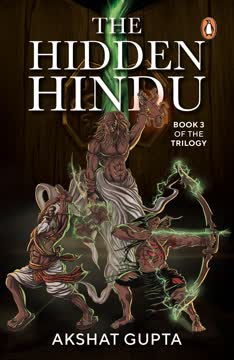
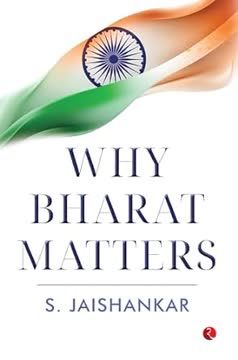




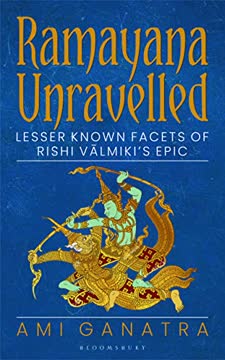


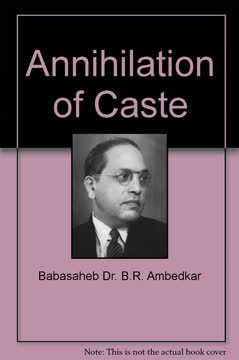
Download PDF
Download EPUB
.epub digital book format is ideal for reading ebooks on phones, tablets, and e-readers.
